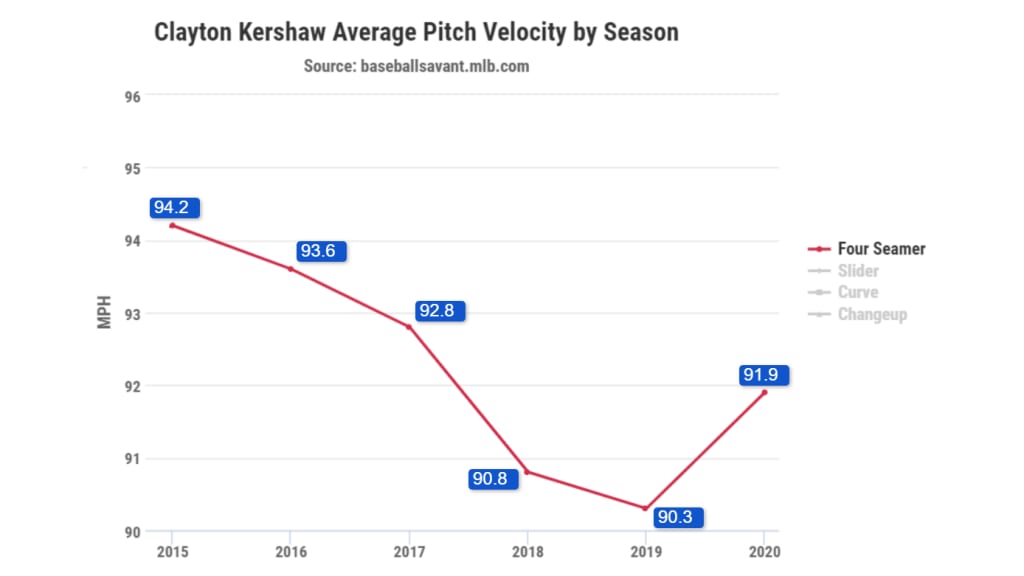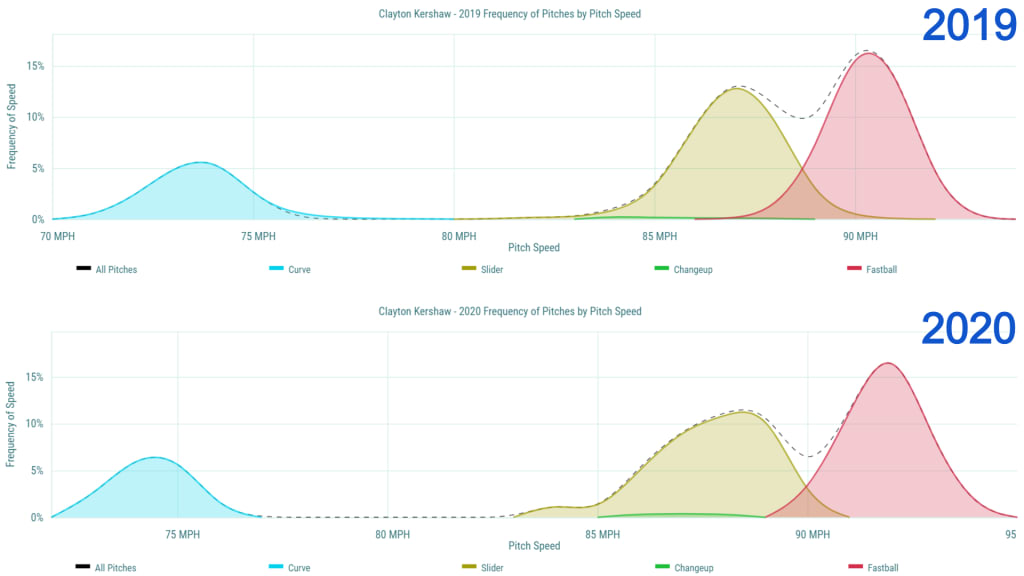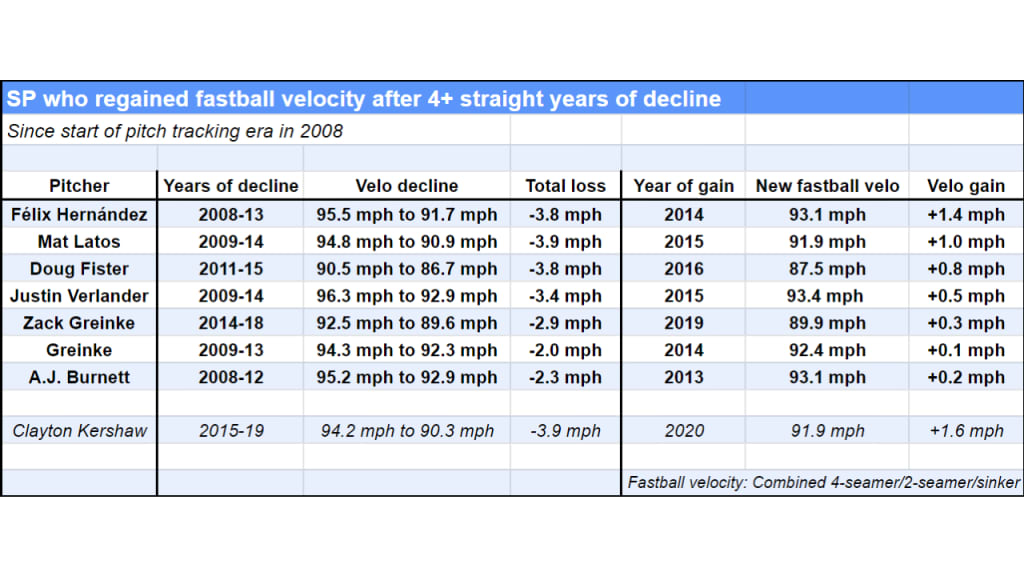Check out this graph of Clayton Kershaw fastball velocity since 2015. You might be familiar with the worrying downward trend from 2015-19 -- four straight years of declining velo -- as Kershaw slipped from 94.2 mph all the way down to 90.3 mph.
But that brings us to 2020, and … wow, look at that:

Kershaw has gained back over a mile and a half per hour of velocity this season. That's a lot. It's great to see from the Dodgers ace, who has a 2.65 ERA and 18 strikeouts entering his fourth start of the season Thursday against the Mariners. And it's a welcome surprise -- this kind of regained velocity is rare for a pitcher.
Let's take a closer look at 2020 Kershaw.
He's throwing his hardest since 2017
You can see just from the graph that Kershaw's fastball is at its fastest level in three years. And that's just his average velo. Kershaw's max velo has ticked up, too.
In his season debut on Aug. 2, when he threw 5 2/3 shutout innings against the D-backs, Kershaw fired his fastest pitch in over two years -- a called strike to Ildemaro Vargas at 93.3 mph, a velocity he'd last reached on April 3, 2018.
Two starts later, Kershaw topped out at 93.6 mph, humming a fastball past Shohei Ohtani on the outside edge for a swinging strike in his last batter of a seven-inning, one-run gem. That was the fastest pitch Kershaw had thrown since the 2017 season.
Kershaw has gotten nine called or swinging strikes this season on pitches 92.6 mph or harder, including punching out Mike Trout. Why 92.6? That's Kershaw's max velocity from the entire 2019 season. The strikeout of Trout was Kershaw's fastest strikeout pitch since the 2017 playoffs.
In 2018, only 10% of Kershaw's fastballs came in at 92 mph or faster. In 2019, it dropped to less than 2%. In 2020, 44% of Kershaw's fastballs are 92 mph or harder.
To look at it another way, Kershaw is throwing a lot fewer slow fastballs. In 2017, he never once dipped under the 90 mph mark. But in 2018, one in five fastballs he threw was below 90. And last year, over a third of his fastballs were sub-90. This season, only one of Kershaw's 108 four-seamers hasn't hit the 90 mph mark.

Kershaw's velo gain stands out for two reasons. One, you just always want to pay attention when an ace pitcher starts throwing harder -- just look at Jacob deGrom. And two, because once you have prolonged velocity loss, it doesn't usually just come back.
Few pitchers have velo bouncebacks like Kershaw's
When one of the best pitchers of his era throws slower and slower -- and throws correspondingly fewer and fewer fastballs, as Kershaw did, until his four-seam and slider usage were basically equal -- that grabs the headlines. The worst fear was that for Kershaw, velo loss was an indicator of a pitcher in his 30s with a recent history of back issues losing his best stuff. And yet, in 2020, Kershaw is decisively reversing his own pattern.
It's hard for a pitcher to even maintain status as a regular starter in the Majors through years of continued velocity loss. Kershaw is the exception who can pitch successfully with lower velocity -- but he doesn't have lower velocity anymore.
To put Kershaw's velocity inflection in context, MLB Statcast database guru Jason Bernard looked at all instances in the pitch tracking era (since 2008) of a regular starter losing fastball velocity for four or more years in a row. Only a handful were able to break the downward trend and regain any velocity at all. None added back as much velo as Kershaw.

King Félix, Verlander and Greinke are the ones you want to pay the most attention to, since they're the most like Kershaw, in that they're also generational pitchers. Not only did all three regain velocity, all three pitched at a Cy Young-caliber level afterwards.
When Félix's velocity spiked like Kershaw's in 2014, after five seasons of decline, he won the AL ERA title at 2.14 and struck out a career-high 248 batters. (Note that we're not talking about the current velocity decline he's been on, which is much more severe and career-altering).
Verlander went from a 4.54 ERA with lower velocity in 2014 -- his worst mark in six years -- to a 3.38 ERA in '15. The next year, the Tigers ace lowered his ERA to 3.04 and racked up an AL-leading 254 strikeouts. And he found his old explosive four-seamer following his trade to the Astros in 2017, lifting his career to new heights, including his first 300-strikeout season and a second Cy Young Award last year.
Greinke's two velocity bouncebacks were only incremental, but he still produced sub-three ERAs in both of those seasons -- 2.71 as Kersaw's teammate with the Dodgers in 2014 and 2.93 with the D-backs and Astros last year.
It's worth noting that Kershaw visited the data-driven Driveline Baseball in the offseason for a pitch assessment, as reported by The Athletic's Pedro Moura -- though, as Kershaw was quick to note, Driveline is "not necessarily just a weighted-ball program" for velocity purposes.
But what he told The Athletic is interesting, especially given the early 2020 returns: "They’re smart in how the body works, and how to create the most efficiency with your body, and how to create the most power with your body," Kershaw said. "They have ways to apply that. I think you can glean different things from different usages of it."
Throwing harder helps Kershaw's fastball-slider combo
Velocity is one thing. Results are another. Kershaw has the results in the stat sheet, but if you isolate his fastball numbers specifically, they look very similar to a season ago even though he's throwing harder.
Kershaw's batting average allowed on four-seamers is sitting around .230 just like it did in 2019, for example, and he's getting whiffs on just over 17% of swings against it, just like he did in 2019.
But the key is not what Kershaw's four-seamer does by itself. The key is what it does in conjunction with his slider. That's where the new velocity helps.
Three fourths of Kershaw's swinging strikes this season have come on his slider, compared to one fifth on his four-seamer. But if Kershaw doesn't attack the way he does the four-seamer, he doesn't get the whiffs with the slider. You start to see that if you add his called + swinging strikes. Then the split between fastball and slider is even. And you can see the beauty of the two in tandem when you look at how Kershaw tunnels his arsenal.

Kershaw's four-seamer and slider start off close together at the "recognition point" (when the batter can discern the pitch type), and they're nearly identical at the "commit point" -- when the batter has to decide whether to swing, before it's too late.
That's what you want. Kershaw's four-seamer and slider very closely resemble each other, and because they so closely resemble each other out of his hand, his extra velocity makes it even harder on the hitter at the plate.
Kershaw's four-seamer is getting more "rise" this season -- he's at +2.8 inches of rise above average -- and with him throwing it harder, it's dropping about an inch and a half less on its way to the plate. He's throwing his slider harder, too, at 87.7 mph compared to 86.9 mph in 2019, and he's added about an inch of horizontal break, at +1.8 inches above average.
That movement combination is important. Kershaw throws a "true" four-seamer -- it has rising action with almost no horizontal movement at all. Meanwhile, his slider has very little vertical drop, but it does take that hard little right turn on its way to the plate.
Now think back to how close Kershaw's two primary pitches are to each other at the hitter's decision point. Between there and the plate, the four-seamer rises, and the slider slides away from it. And all of this is happening faster now, giving the hitter less time to solve the puzzle and drive the ball. Kershaw has sharper stuff and the same attacking mentality he's always had. It's a good combination.
